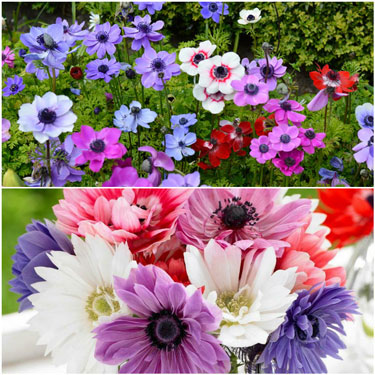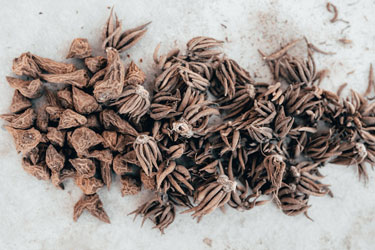Easy spring colour
Garden centres are full with displays of bulbs in colourful packs, or loose to buy, from February. Daffodils, tulips, hyacinths and freesias are the most sought after but let’s not forget some of the smaller bulbs that are delightful in their own way because they are not so often seen in public displays. Some of the earliest bulbs to arrive on the shelves are the two treasures Anemones and Ranunculus.
ANEMONES
Anemones (also known as Windflowers, from the Greek word for wind ‘anemos’) are one of the easiest ways to add colour and beauty to your Spring garden. Simple to grow, and incredibly floriferous, these tiny unassuming tubers know how to deliver! Anemones make great cut flowers and look particularly fantastic planted in mass displays and this may simply be in a pot or a small garden bed. To prolong your display, they can even be stagger planted.
There are two main Anemone varieties for spring flowering:
- The single flowered De Caen, often referred to as ‘Poppy’ anemones, originating and named from the city of Caen in the Normandy region of France
- The double flowered ‘St Brigid’, which hail from Ireland and bear the name of the patron saint of that country.
Both come in the same shades of white, pink, red and blue, and occasionally a dark red wine colour (Bordeaux).
Anemones can be planted anytime from February through to late May, although it is recommended the tubers be chilled in a paper bag in the fridge for around 3-5 weeks. This will give them a good kick start.
Choose a site that is sunny or with dappled shade, and free draining soil. Loosen the soil down to 10-15cm and enrich with compost and bulb food.
Before planting, soak the Anemone tubers in tepid water for around 2 hours, which will plump them up and hasten sprouting. Push the tubers into the soil (pointy end facing downwards) with your finger at 10 to 15cm apart and to a depth of 3 to 5cm. Water well after planting, then keep the area moist but not wet, as the tubers sprout and eventually flower.
Anemones enjoy extra food, so a few side dressings of bulb food while growing will enhance their flower production and flowering life.
Anemones will grow just as well in containers, using the same planting principles and good quality potting mix. Use either slow release fertiliser to feed them or the bulb food sparingly so as not to burn the roots.
Anemones are great as cut flowers. Cut them off at the base, which will promote more blooms, as soon as they are open. Add flower food to the water to keep the flowers brilliantly coloured.
The foliage will die back late spring and you can either dig the tubers up to store and plant next autumn, or simply leave them to pop up next year. If you’re wanting a beautiful display every year it’s recommended to buy in new stock each season as Anemones won’t do as well in subsequent seasons.
RANUNCULUS
Ranunculus—also known as Persian buttercups—are popular for their eye-catching pastel colours, double ruffled flowers and long vase life. Ranunculus corms are fairly unusual looking as they have small fleshy roots, known as claws attached. All common hybrids have been developed from breeding Ranunculus asiaticus, native to the Mediterranean, north African and some Asian regions.
If you can grow Anemones, you can grow Ranunculus as their cultivation and requirements are very similar. Follow the advice above while noting these small differences:
- Plant the corms with the ‘claws’ pointing downwards.
- Plant in full sun.
- Pick the blooms when the buds begin to show colour and before they unfurl. They will last in a vase for up to 14 days.

1-Mar-2022

Anemone De Caen (top) and double flowered St Brigid

Anemone corms (left) and ranunculus corms (claws)

Ranunculus flowers

Rose-like ranunculus combined in pot with white alyssum and purple nemesia

